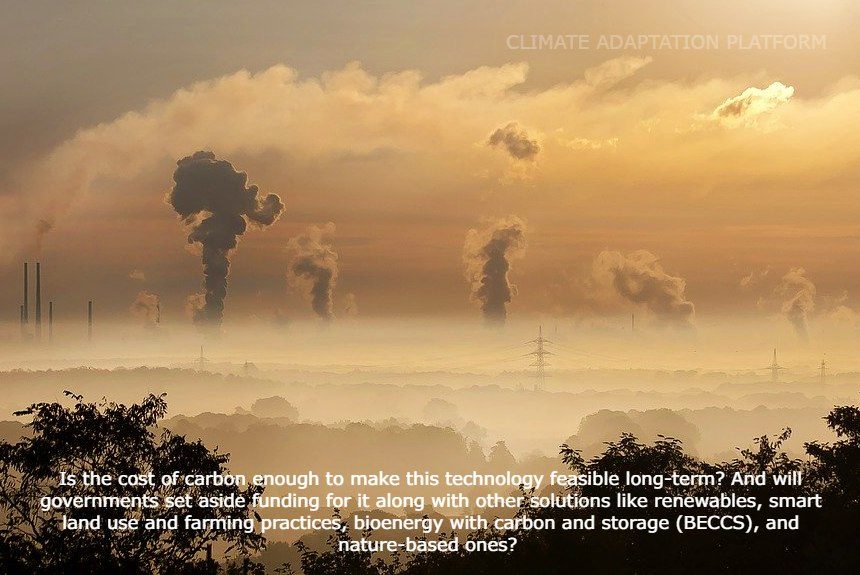The idea of direct carbon capture from the atmosphere to stop climate change has been around for over a decade, but this technology has only recently been tested in the real world.
A CNBC video features a company called Carbon Engineering, based in Squamish, British Columbia. It has built a pilot plant that sucks carbon dioxide from the atmosphere using direct capture technology (DAC).
Its CEO, Steve Oldham, claims that one of its plants can do the work of 40 million trees. David Keith, a Harvard Professor and the company’s chief scientist, says that the technology they use to capture carbon has the lowest capital and energy costs of any CO2 capture from the atmosphere solution.
Oldham says that we have a big problem with large quantities of CO2 in the atmosphere. If we have a mechanism to collect it on a large scale, it will give us the flexibility to address climate change and will start to address emissions from yesterday, today, and all the way back to the industrial age.
The video explains how DAC uses giant fans and complex chemical processes to remove CO2 from the air. They have announced the building of its first commercial plant.
The video says that captured carbon will either be stored underground or used to create fuels. The plant is powered by a combination of renewable energy and natural gas, and the CO2 generated is captured. Eventually, the company plans to run fully on renewable energy.
Carbon Engineering will also use its captured carbon to produce synthetic fuels. Geoff Holmes, Business Development of Carbon Engineering, says that synthetic fuels have 70 to 90 per cent less carbon than conventional fuels and that, with more technological innovation, they can reach zero per cent carbon.
The technology looks very promising, but not everyone shares the same enthusiasm for it because this project is backed and funded by giant oil companies.
Dan Kammen, Professor of Energy at the University of California, Berkeley, said that (Carbon Engineering) partnering with oil companies is stepping in the wrong direction, and if you are part of the solution, then the technology (should) not be a shield or a cover for fossil fuels. You are either a part of the effort to grow the green energy economy without perpetuating the dirty energy, or, sadly, carbon engineering is on the wrong side of the equation, he adds.
Mark Jacobson, a professor of Civil and Environmental Engineering at Stanford University, says that they are not stopping the fossil fuel industry but promoting it.
Kamen thinks the carbon price needs to be higher before direct capture makes any sense. At $5 to $20 per metric ton, he believes the technology is not financially viable compared to renewables such as solar and wind energy.
The challenge to the feasibility of carbon capture is that without public investment or more stringent prices on carbon pricing initiatives, there is no monetary incentive for Carbon Engineering to bury carbon underground without treating the product like crude or synthetic oil.
Oldham said that governments are not funding carbon removal technology, and to the critics, he asks, ‘Do they want us to wait?’
Sabin Fuss, Head of Mercator Institute’s Sustainable Resource Management and Global Change, is considering DAC as one of the solutions to climate change, given its urgency.
She says that they are assessing many different pathways to reach 1.5C, but none of them reaches the temperature target without removing CO2 from the atmosphere. She adds that each year that we wait, we are making ourselves dependent on carbon removal.
Fiona Wil, BHP Vice President for Climate Change and Sustainability, says that we need all the solutions for climate change, including more of them, such as renewables, direct air capture, carbon capture and storage, nature-based solutions, and informed policy development. The challenge of climate change is so great that the time for picking winners is gone, and we must take all the above approaches.
Watch the video to know the merits of direct air capture and whether this can be a great solution to mitigate and adapt to climate change.
Sources
Bill Gates-backed Carbon Capture Plant Does The Work of 40 Million Trees. (2019, June 22). CNBC [Video file]. Retrieved from https://www.youtube.com/watch?v=XHX9pmQ6m_s



Leave a Reply